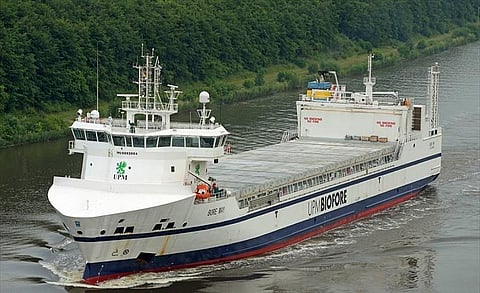

Finnish cargo shipping company Bore, a company under Netherlands-based the Spliethoff Group, recently took delivery of a new Ro-Lo vessel.
Designed by Dutch naval architecture firm Conoship International and built by Wuhu Shipyard in China, Bore Way is of ice-strengthened construction – possessing Swedish/Finnish ice class 1A notation – and was developed to comply with the client's technological, operational, and environmental standards in anticipation of IMO emissions regulations scheduled to come into effect in the next decade.
The DNV-classed newbuild has a length of 120 metres, a moulded beam of 21 metres, a design draught of 6.75 metres, a deadweight of 7,000 tonnes, a maximum speed of 15 knots, and a service speed of 13.5 knots. It will be capable of transporting Ro-Ro, container, and project cargo. Jørgen Mansnerus, Vice President Marine Management at Bore, said the ability to accommodate varied cargo types became necessary due to the vessel's intended role of carrying forestry products.
The ship's 65-metre-long hold has 10,600 square metres of area for storing assorted Ro-Ro and containerised cargo. A maximum of 264 TEUs can be transported split equally between the hold and the top deck.
A stern ramp provides access for lorries and heavy cargo handling equipment. With the superstructure in far forward position, the cargo hold is also fully accessible from above by gantry cranes, and the lift-off hatch covers are strong enough to carry containers.
DNV said the entire design focuses on maximising cargo space, which means that all machinery is confined to the spaces below the large, open cargo hold. The accommodations for the 12-strong crew will be in the bow section, thus ensuring that all available spaces can be used.
Jan Jaap Nieuwenhuis, Manager of the Design Department at Conoship International, explained that the transport of paper reels involves the most stringent requirements even with the ability to carry a wide variety of forestry products, whether in break bulk form, on trailers or in containers. Hence, the calculations for the design are based on paper reels as reference cargo. This then meant that the ship design needed to provide exceptional structural strength and rigidity to avoid elastic deformation in rough sea conditions or while loading and unloading heavy rolls of paper.
As paper is highly sensitive to temperature and air moisture changes, the cargo needed to be protected from quality-damaging environmental influences, such as significant changes in ambient conditions while in transit. It is thus extremely important that the hatch covers and the stern ramp form tight seals when closed, and that the cargo hold is climate-controlled. Dehumidification of the hold required an extensive system of air ducts integrated into the walls of the hold itself, all the while meeting the required damage stability criteria. The ducts ensure a continuous horizontal air flow throughout the entire cargo space without leaving any dead spots.
The propulsion system will include a 3,180kW, four-stroke dual-fuel engine that can operate on either MGO or LNG, the latter fuel being supplied by a 250-cubic-metre type C tank. Mansnerus said the tank capacity is sufficient for one round trip between Finland and western Europe.
The main engine drives a large-diameter, controllable-pitch propeller. The engine can operate either in continuous or in flexible rpm mode, depending on the situation, to further improve efficiency. Mansnerus said that during the design development phase, extensive model basin tests and advanced computer-based CFD analysis were performed to optimise the design of the hull lines and the interaction between hull, propeller, and rudder. The result is a ship that is about ten per cent more efficient than conventionally-powered counterparts.
The ship also has two 250kW auxiliary engines and a 500kW bow thruster to aid in manoeuvring in close quarters.
Bore Way will operate on north-western European cargo routes under a long-term charter with UPM, a paper products company headquartered in Helsinki. The same charter will also be served by the newbuild's two near-identical sister ships, which are under construction in China.
| Bore Way | |
| SPECIFICATIONS | |
| Type of vessel: | Ro-Lo vessel |
| Classification: | DNV; Swedish/Finnish ice class 1A |
| Port of registry: | Helsinki, Finland |
| Flag: | Finland |
| Owner: | Spliethoff Group, Netherlands |
| Operator: | Bore, Finland |
| Designer: | Conoship International, Netherlands |
| Builder: | Wuhu Shipyard, China |
| Length overall: | 120 metres |
| Beam: | 21 metres |
| Draught: | 6.75 metres |
| Deadweight tonnage: | 7,000 |
| Capacity: | 264 TEUs; 10,000 square metres |
| Main engine: | 3,180 kW |
| Propulsion: | Controllable-pitch propeller |
| Auxiliary engines: | 2 x 250 kW |
| Side thruster: | 500 kW |
| Maximum speed: | 15 knots |
| Cruising speed: | 13.5 knots |
| Types of fuel: | MGO; LNG |
| Fuel capacity: | 250 cubic metres |
| Crew: | 12 |
| Operational area: | North-Western Europe |
